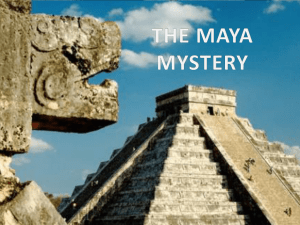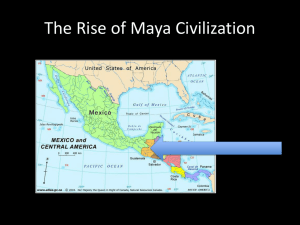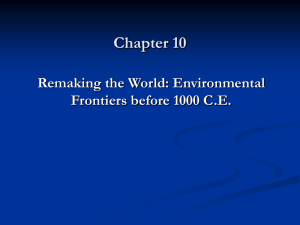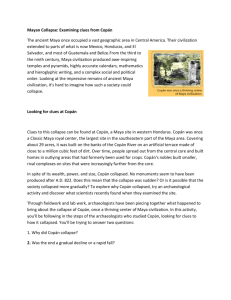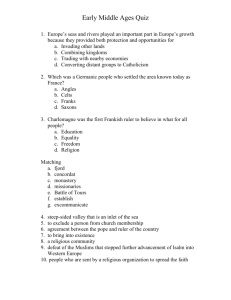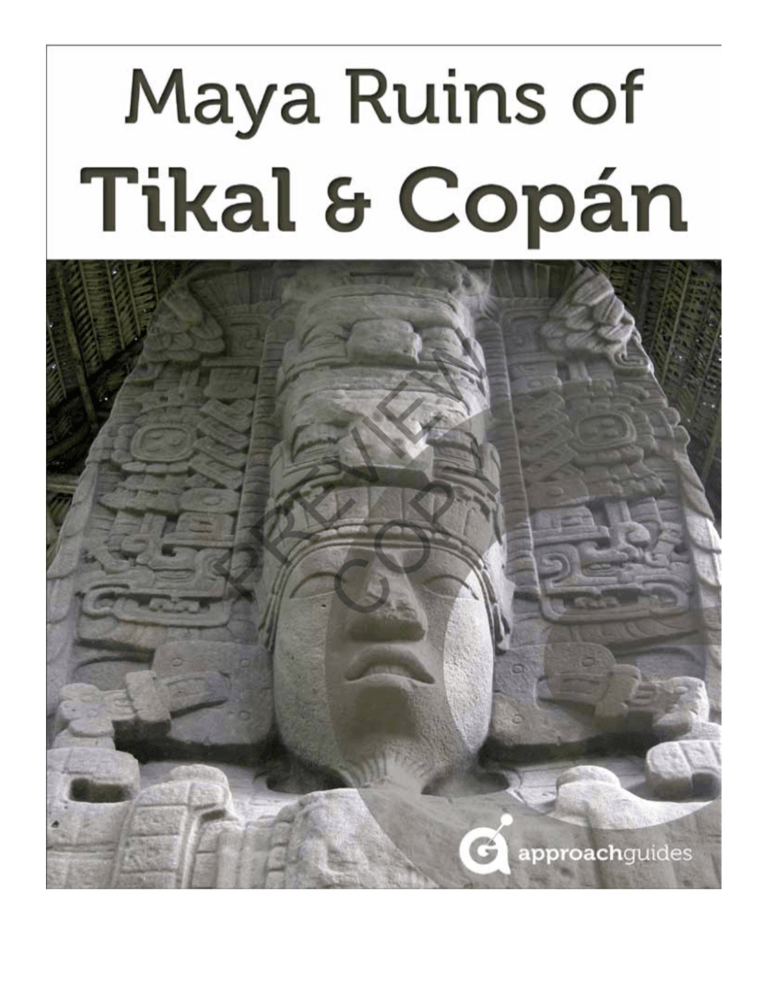
PR
E
C VI
O E
PY W
Introduction
Note to customers previewing this guidebook
If you are previewing this guidebook in advance of purchase, please check out our enhanced
preview, which will give you a deeper look at this guidebook.
Travel guidebooks for the ultra curious, Approach Guides reveal a destination’s essence by exploring
a compelling aspect of its cultural heritage: art, architecture, history, food or wine.
The Maya religious centers of Tikal and Copán are one of Mesoamerica’s cultural treasures, the remains of a great civilization that prospered for 2,000 years (peaking from 600-800 CE) and created
some of the most impressive art and architecture in the New World. Still infused with their historical
magic, they are yours to discover.
What’s in this guidebook
• Background. We start off by providing some critical background information — focusing on
cosmology and the role of the dynastic ruler — that makes sense of the forms and symbols of
the unique Maya aesthetic.
• Tours of Tikal and Copán. Following our tradition of being the most valuable resource
for culture-focused travelers, we then turn our attention to two of the most spectacular Maya
cities: Guatemala’s Tikal and Honduras’ Copán. For each city, we start by introducing the distinctive features of its art and architecture, isolating key features and concepts that you will
see again and again as you make your way through the site. The tours walk you through the
highlights, aided by high-resolution images and a discussion that ties it all together.
• Bonus site: Quiriguá. As a special bonus, we also profile the smaller Maya site of Quiriguá,
an ideal addition to your existing Tikal and/or Copán itinerary.
• Advice for getting the best cultural experience. To help you plan your visit, this guidebook supplies logistical advice, detailed maps and links to online resources. Plus, we give our
personal tips for getting the most from your experience while on location.
• Information the way you like it. As with all of our guides, this book is optimized for intuitive, quick navigation; information is organized into bullet points to make absorption easy;
and images are marked up with text that explains important features.
Contact us anytime
Our readers are our greatest inspiration. Email us at founders@approachguides.com to let us know
about your experience with Approach Guides — many of our recent updates have been inspired by
customers like you. We personally respond to every email.
We hope this cultural guidebook offers you fresh insights into the art and architecture of Tikal and
Copán and sets you on a path to making your own discoveries.
Have a great trip!
David and Jennifer Raezer
Founders, Approach Guides
www.approachguides.com
Continuing Travel in the Americas
New York City
New York City’s TriBeCa and SoHo neighborhoods in downtown Manhattan are home to the largest
concentration of cast iron facades in the world. Explore these architectural masterpieces with our
walking tour and guide to New York City.
Start reading: Cast Iron Architecture in New York City
Mexico
If you plan on visiting Mexico, download our guidebook to its greatest Maya sites, including Chichen
Itza, Tulum, Palenque, Bonampak, and more. As with our guide to Tikal and Copán, we offer insightful coverage — spanning history, art, architecture — available nowhere else.
Start reading: Maya Ruins of Mexico
Maya Ruins of Tikal and Copán
Version 1.0
by David Raezer and Jennifer Raezer
© 2015 by Approach Guides
All rights reserved. No part of this book may be reproduced in any form or by any electronic or mechanical means, without permission in writing from the publisher (excluding Creative Commons images). Further, this book is licensed for
your personal enjoyment only and may not be resold or given away to other people.
Copyright, licensing and attribution information can be found in the metadata for all images and illustrations.
Approach Guides and the Approach Guides logo are trademarks of Approach Guides LLC. Other marks are the property
of their respective owners.
Although every effort was made to ensure that the information was as accurate as possible, we accept no responsibility
for any loss, damage, injury or inconvenience sustained by anyone using this guidebook.
Approach Guides
New York, NY
www.approachguides.com
ISBN: 978-1-936614-38-7
Contents
Contents
Introduction
The Maya in Guatemala and Honduras
Know Before You Go
Maya Cosmology
The Cult of the Ruler
Sculpture as Political Tool
Maya Stelae: Style and Evolution
PR
E
C VI
O E
PY W
Maya Cosmological Symbols
TIKAL (GUATEMALA)
Background and History
Tikal’s Architectural Styles
The Late Preclassic Style
The Early Classic Style
The Late Classic Style
Map and Tour Itinerary
1. Great Plaza and North Acropolis
Map of Great Plaza and North Acropolis
1a. North Acropolis
1b. Structure 43
1c. Great Plaza: Temples I and II
1d. Great Plaza Stelae
2. Lost World Complex (Mundo Perdido)
2a. Pyramid 49
2b. Pyramid 54
3. Temple IV
4. Temple of the Inscriptions
5. Museums
5a. Stela 31 (Museo Tikal)
5b. Stela 16 (Museo Lítico)
5c. Altar 5 (Museo Lítico)
5d. Stela 22 (Museo Lítico)
6. Twin Pyramid Group Q
COPÁN (HONDURAS)
Background and History
PR
E
C VI
O E
PY W
Copán’s Architecture and Carved Reliefs
Map and Tour Itinerary
1. West Court
1a. Pyramid 16 and Rosalila
1b. Altar Q
1c. Stela P
1d. Pyramid 11
2. East Court
2a. Building 22
3. Court of the Hieroglyphic Stairway
3a. Pyramid 26 and the Stairway
3b. Stela M
4. Ballcourt
5. Great Plaza
5a. Stela A
5b. Stela B
5c. Stela C
5d. Altar G1
5e. Stela H
QUIRIGUÁ (GUATEMALA)
Background and History
Quiriguá’s Sculpted Monuments
Stelae
Zoomorphs
Map and Tour Itinerary
1. Stela C
2. Stela D
3. Zoomorph B
5. Stela F
6. Stela I
7. Zoomorph P
PR
E
C VI
O E
PY W
4. Stela E
8. Altar of Zoomorph P
Maya: The Big Picture
Map of Maya in Mesoamerica
Timeline
Important Dates in Maya History
Video Overview
About Approach Guides
Contact
Free Updates and Enhancements
More from Approach Guides
—
THIS IS THE ACCOUNT
of when all is still silent and placid.
All is silent and calm ...
All alone the sky exists.
The face of the earth has not yet appeared.
Alone lies the expanse of the sea,
along with the womb of all the sky.
There is not yet anything gathered together.
All is at rest.
Nothing stirs …
All lies placid and silent in the darkness,
in the night.
—
PR
E
C VI
O E
PY W
Excerpt from the Preamble of the Maya Popol Vuh
Translation by Allen J. Christenson
http://aprch.us/popol-vuh
The Maya in Guatemala and Honduras
Premier Maya sites in Guatemala and Honduras. See in Google Maps
The Maya civilization thrived for approximately 2,000 years in Mesoamerica, an area that encompasses present-day southern Mexico, Guatemala, Belize, El Salvador, and Honduras. Peaking from
600-800 CE (the Late Classic period), it created art and architecture that, even in its ruined state,
inspires contemplation and wonder.
This Approach Guide focuses on the premier Maya sites in Guatemala and Honduras: Tikal and
Copán. It also includes a tour of the smaller site of Quiriguá, a worthwhile and potentially easy addition to your existing itinerary.
• Tikal. Occupying a massive site in northern Guatemala, Tikal was a superpower of the ancient
world. The city’s architecture, with remains of soaring temples from the Preclassic and Classic
periods, is unsurpassed. It is striking in its scale and diversity of monuments.
• Copán. A mid-sized site located in western Honduras, Copán has a limited architectural legacy, yet it hosts more hieroglyphic inscriptions and sculpted monuments than any other Maya
site. For travelers seeking insight into Maya artistic expression, Copán offers an incomparable
experience.
• Quiriguá. A small site in southeastern Guatemala, Quiriguá is not visited by many travelers,
but it should be. It has the largest sculpted monuments in the Maya world, not to mention
awe-inspiring zoomorphic sculptures.
Author Tip: We encourage you to review a collection of background information on the
Maya — a map showing the locations of prominent Maya sites, a timeline, a brief summary of
Maya history, and a video by one of the foremost experts on the Maya — in the final section of
this Approach Guide, entitled “Maya: The Big Picture.”
Know Before You Go
Before beginning our tours of Tikal and Copán, the following sections offer a few critical insights into
the functioning of Maya civilization that will prove quite valuable in making sense of each site’s art
and architecture.
• Cosmology. Cosmology was the foundation for the civilization’s art and architecture, functioning as the source material for their underlying narratives, forms, and symbols. We provide
the basics on the Maya worldview to help you appreciate the symbolic associations that monuments were designed to communicate.
• Cult of the ruler. The Classic period ruler was the primary human figure in the Maya cosmological universe; as the link with the world beyond the living, he was responsible for the
prosperity of his people. We explain his fundamental role.
• Sculpture as political tool. The ruler used art and architecture to reinforce the importance
of his cosmological role, thereby expanding his power and prestige. To illustrate this point, we
reveal how this objective sparked the change to a new form of sculptural expression.
• Maya stelae: style and evolution. Stelae were the primary artistic form used to advance
the cult of the ruler. We explain the general characteristics of the style employed in these
carved monuments and how they took on unique expression in specific areas of Mesoamerica.
• Cosmological symbols. Finally, we examine the most common symbols used by the ruler
on his works of art and architecture. You will see these symbols appear again and again on
both tours.
— Pages Missing —
Download the complete book online at www.approachguides.com
PR
E
C VI
O E
PY W
Fig. 7. Stela A, Copán. Highlights added.
Symbolism
The serpent was the means of conveying a hallucinatory vision; the shape of its body mimicked the
wisps of rising smoke from ritual burned blood offerings. The ruler performed these offerings, and
by holding the snake-shaped bar in his hands, he reinforced his ritual role in communicating with ancestors (in the Underworld) and gods (in the heavens); it is the successful
accomplishment of this role that assured the survival and prosperity of his people.
— Pages Missing —
Download the complete book online at www.approachguides.com
PR
E
C VI
O E
PY W
Fig. 20. Late Classic style temple (Temple II), Tikal. Highlights added.
Decorative Features
• Massive decorated roof combs. The roof combs atop temples (red highlights in Fig. 20)
grew in size and their painted stucco reliefs became more elaborate. They are the focus of
temples’ exterior decoration.
• Apron moldings. Continuing the tradition begun in the Preclassic, each level of the pyramid is accentuated with apron moldings (green highlights in Fig. 20). They provide a subtle
horizontal balance to the sharp vertical lines of the pyramid; further, the shadows that result
from the moldings’ subtle outward projections add a three dimensional quality to the facade.
• Stelae abound. The Early Classic practice of complementing architectural art with freestanding stelae gains further momentum by the Late Classic. Elaborately-decorated stelae —
carved from limestone blocks — reside on the periphery of courtyards, standing before architectural monuments; the stelae are fronted by low, round, flat-topped altars.
Twin Pyramid Groups
Building upon Preclassic triadic group precedent, Tikal’s Late Classic architects paid particularly
acute attention to the arrangement of space among groups of structures, rather than just
focusing on a single structure in isolation.
PR
E
C VI
O E
PY W
Leveraging Jasaw’s Great Plaza as a model, the framework for a distinctive layout was introduced,
what would come to be known as a twin pyramid group: paired temples face each other across an
east-west oriented courtyard; the courtyard is bounded on the north by a funerary offering complex
and on the south by an administrative center.
This temple arrangement is discussed in more detail in the section entitled “6. Twin Pyramid Group
Q.”
Where to See It
First and foremost, Tikal is a Late Classic site. The Late Classic architectural style is best exemplified in the Great Plaza’s Temples I and II, but it is visible everywhere. Given the large number
of temples and their high state of preservation, Tikal is the best place in the Maya world to view this
style.
Tikal’s Late Classic architecture is visible in the following areas:
•
•
•
•
•
•
Great Plaza: Temples I, II, 33.
Temple III.*
Temple IV.
Temple V.*
Temple VI (Temple of the Inscriptions).
Twin pyramid groups L-R.
* While these structures are not specifically profiled in this guidebook, they are included on the map in the section
entitled “Map and Tour Itinerary.”
PR
E
C VI
O E
PY W
Map and Tour Itinerary
Fig. 21. Map of Tikal. Highlights added.
Tour of Tikal’s Premier Sites
To make exploring this massive site easier, we have organized our tour of Tikal into six chapters,
each tied to a specific area of great interest.
— Pages Missing —
Download the complete book online at www.approachguides.com
1c. Great Plaza: Temples I and II
A New Sacred Center
The Late Classic transformation of the city began under Ruler 26, Jasaw Chan K’awiil. By building
funerary monuments south of the North Acropolis, Jasaw broke with historical precedent,
creating a new sacred center for the Late Classic city. The Great Plaza symbolized a new era for
Tikal under Jasaw, free from foreign occupation and the negative memories associated with the
Hiatus (562-682).
Quintessential twin pyramid group
PR
E
C VI
O E
PY W
The Great Plaza’s arrangement became a continually referenced prototype for the twin pyramid groups that abound in Late Classic Tikal.
• Organized in an east-west alignment, Temples I and II face each other across a grand
courtyard, symbols of earthly existence (light blue highlights in Fig 23).
• Temple 33 anchors the northern edge of the courtyard (yellow highlights in Fig 23), symbolic of the heavens.
• The royal palaces and administrative structures of the Central Acropolis — comprised of a
maze of 42 buildings on multiple levels — bounds the southern edge (dark blue highlights in
Fig 23), symbolic of the Underworld.
Ritual activity
The Great Plaza’s design creates two distinct areas of ritual activity:
• Atop the pyramids, the ruler and members of the society’s elite conducted ceremonies
inside the sacred inner chambers of the temples.
• In the courtyard, the ritual activity of the regular citizens focused on the altars and stelae
at the bases of the pyramids. There was likely minimal interaction with those atop the pyramids, as there are only small platforms outside the temples and there is no visibility into
their interiors.
The separation of social classes into two distinct spheres of worship appears to differ from Copán,
where in the East Court’s Structure 22 (profiled under Copán in the section entitled “2. East
Court”), there was a shared ritual experience.
PR
E
C VI
O E
PY W
Fig. 27. Temple I, Great Plaza, Tikal. Photo by: Dennis Jarvis.
Temple I
Temple I (Fig. 27) was dedicated to Jasaw Chan K’awiil and was probably constructed around
the time of his death in 734. His tomb, discovered deep inside the pyramid’s interior, was built
(and filled with Jasaw’s body) first and the pyramid-temple was subsequently erected over it. Although designed by Jasaw himself, construction necessarily occurred under his son and successor,
Yik’in Chan K’awiil. The Museo Tikal holds a reconstruction of the interior of Jasaw’s tomb.
View from the base
PR
E
C VI
O E
PY W
• The temple faces westward toward Temple II; as the location of the setting sun, the
western horizon was symbolically associated with death, which matches the tomb’s funerary
orientation.
• Temples I and II are connected as part of a triadic group with their prototype, Temple
33 (detailed description in section entitled “1a. North Acropolis”). This arrangement links
Ruler Jasaw Chan K’awiil (in Temple I) with his wife (in Temple II) and his father (in Temple
33).
• The structure rises 47 meters (154 feet) over the Great Plaza.
• It epitomize Tikal’s Late Classic style: pronounced verticality; large roof comb; a single
stairway leading to a single-door entrance; and redented corners (yellow highlights in Fig.
28). For more on the style, see the section entitled “The Late Classic Style.”
• The pyramid rises in nine terraced levels with sloping walls, symbolic of the nine levels
of the Underworld, as was typical for Maya funerary monuments; the deceased ruler’s spirit
would have to pass through these levels in its ascent into the heavens.
• The roof comb — resting on the mansard roof of the temple below — originally held a
stucco relief sculpture of the seated ruler (likely originally painted in bright colors), which is
now only barely discernible.
PR
E
C VI
O E
PY W
Fig. 28. Floorplan, Temple I, Great Plaza, Tikal. Highlights added.
View from the summit
• The temple atop the pyramid has three corbel-vaulted chambers (red highlights in Fig.
28), with the level of the floor rising from entrance to rear. Consistent with the use of corbelled vaulting, the walls of the temple are especially thick; in fact, the walls make up
a greater portion of total interior space than the open chambers.
• Red wood beams from the sapodilla tree — best known for its gummy sap, called chicle,
which is the source of the original chewing gum — were added as lintels above the doorways
providing access to each of the internal chambers (Fig. 28). The lintels above the interior
doorways held elaborate low-relief carvings of the ruler surrounded by protective
deities: an enormous jaguar god that stands behind and extends its claw in defense of the
ruler (see a drawing of Lintel 3 online); and a cosmic serpent that coils itself atop the ruler’s
head (see a drawing of Lintel 2 online). These deities will reappear in a similar context in
Temple IV.
— Pages Missing —
Download the complete book online at www.approachguides.com
View from the Base
PR
E
C VI
O E
PY W
• Temple IV faces eastward toward the Great Plaza, the location of his parents’ funerary
monuments.
• It is the tallest temple-pyramid at Tikal and in Mesoamerica, measuring 64.6 meters (212 feet); unlike Temples I and II, it rests on an enormous platform, 144 by 108 metres
(472 by 354 feet). From a height perspective, the most comparable structure in Mesoamerica
is Teotihuacan’s Pyramid of the Sun (built 100-150 CE): while the Pyramid of the Sun is
ever-so-slightly slightly shorter (64 meters / 210 feet), its larger base dimensions (224 x
224 meters / 735 x 735 feet) make it a significantly more massive structure. Further, when
evaluating the tallest structures in Mesoamerica, the temples of the Preclassic Maya city of El
Mirador (Tigre and Danta) should also be considered: while their pyramids are shorter (30
and 21 meters, respectively), they rest on tall platforms that boost their overall heights to 53
and 70 meters, respectively.
• Overall, Temple IV assumes a squatter appearance than its vertically-oriented Great
Plaza prototypes: Temples I, II, and 33.
• The pyramid rises in seven terraced levels with sloping walls and redented corners.
• The enormous roof comb (Fig. 37) — resting on the mansard roof of the temple below
(the dual slope quality of which is particularly clear, given the restoration) — originally held
a relief sculpture of the seated ruler, however, it is now only vaguely discernible.
View from the Summit
The steep climb up to the summit is worth the effort for the fantastic views.
• Following the pattern set by his parents’ temples, Yik’in’s Temple IV has a single entrance
door and three internal chambers; the level of the floor rises from the entrance to the
rear.
PR
E
C VI
O E
PY W
Fig. 38. Lintel 3, Temple IV, Tikal. Highlights added. Photo by: Jose Fernando.
Lintels
The temple originally held wooden lintels over the entrances to the interior chambers. The lintel of
the doorway leading from the exterior (Lintel 1) was undecorated, but those supporting the entrances to the two interior chambers were carved with victory scenes from two wars initiated
based on the celestial position of Venus:
• Lintel 2 depicts Yik’in Chan K’awiil seated on a palanquin (war booty) at the center of the
composition. Behind him stands the enormous Jaguar War God in anthropomorphic form;
the god extends his arm above the ruler’s head in a gesture of protection. It was sculpted
to commemorate his victory over an opposing city on Long Count 9.15.12.11.13 (6 February
744). See a drawing of this lintel online.
— Pages Missing —
Download the complete book online at www.approachguides.com
Copán’s Architecture and Carved Reliefs
A Limited Architectural Record
Unlike many other Maya sites, Copán does not have soaring pyramid-temples with elaborate decoration. Its architectural legacy is understated. While Copán’s architecture likely never competed
with that of Tikal and other great building centers, its legacy is particularly limited given the following factors unique to the city:
PR
E
C VI
O E
PY W
• The low amounts of limestone in the areas around Copán caused a long-term
issue for stability. Unlike most other Maya sites, builders in Copán lacked abundant supplies of limestone from which to make lime mortar. Accordingly, structures were built with
minimal mortar or no mortar at all (only mud mortar was used in many cases). Instead, the
exteriors of buildings were typically given a coat of lime plaster to protect them from the
elements. Once the city fell, the lime plaster cracked and water was able to penetrate, weakening what were already structurally weak buildings, given their reliance on the Maya corbelled arch for structural support (see a description of the corbelled arch in the Tikal section
entitled “The Early Classic Style”). As a result, many structures simply crumbled over time,
negatively impacting Copán’s architectural cohesiveness.
• Architecture by accretion. It was standard practice in Copán for the latest ruler to destroy and build over what had been built by the prior ruler, what might be termed an architectural style of accretion. Accordingly, Copán’s visible structures do not reveal a historical
chronology (as in Tikal), but rather a snapshot late in its development.
Premier Sculptural Works in the Maya World
Copán more than makes up for what lacks in extant architecture with its unrivaled sculptural monuments, renowned throughout the Maya world.
Expanding upon the Know Before You Go section entitled “Maya Stelae: Style and Evolution,” we
offer a detailed review of the characteristic features of Copán’s stelae, which reach their apex under
Ruler 13.
• Single figure. As at Tikal, compositions on the faces of Copán’s stelae depict only a single
figure, the ruler.
• The size of the stelae is increased. In contrast to the life-size proportions of ruler depictions at Tikal, those at Copán take on larger-than-life proportions, attesting to perhaps an
even stronger cult of the ruler. Copán’s stelae are only surpassed in size by those of Quiriguá,
where rulers take on massive superhuman proportions.
• Full-frontal view. Breaking from the earlier tradition of depicting the ruler’s face in profile, Copán’s stelae show faces in full-frontal views.
• Greater depth of relief and three dimensionality. Under 18 Rabbit, Copán’s stelae
depart from flat, two-dimensional precedent and take on greater three-dimensional, in-theround qualities: the depth of relief increases and decorative details adorn all sides of the
stelae, rather than just the primary side. This design encourages the viewer to move around
•
•
•
•
PR
E
C VI
O E
PY W
•
the monument, taking in unique perspectives.
Static bodies, with dynamic facial expressions. As at Quiriguá, while the bodies of figures are generally static — standing in a fixed position, rather than undertaking some action
— faces reveal a sense of movement, in that rulers appear as if they might be speaking.
Portrait quality. The faces of figures are significantly more realistic — approximating
portraits — than the stylized depictions of Tikal. They are the most naturalistic in the Maya
world.
The narrative function is elevated in importance. The hieroglyphic passages inscribed on the stelae — centering on the name of the ruler who dedicated the monument and
the date on which it occurred — are generally more extensive than those of Tikal, yet more
limited than those of Late Classic Maya cities Yaxchilan and Palenque, where a true historical narrative was communicated.
Ornamentation is greater. The relief work on Copán’s stelae is significantly more detailed and elaborate. Further, consistent with practice in other Maya cities, they were likely
covered with a bright red (iron oxide-based) paint.
Andesite medium. Given the scarcity of limestone, Copán’s stelae are made of andesite,
likely quarried a short distance from the city’s center. Of volcanic origin, the stone has a
faintly yellow-green color, fine texture, and even grain.
PR
E
C VI
O E
PY W
Map and Tour Itinerary
Fig. 46. Map of Copán. Highlights added.
Tour of Copán’s Premier Sites
We have organized our tour of Copán into five chapters, each tied to a specific area of high interest.
The order matches visitors’ typical south-to-north movement through the site.
1.
2.
3.
4.
5.
West Court.
East Court.
Court of the Hieroglyphic Stairway.
Ballcourt.
Great Plaza.
PR
E
C VI
O E
PY W
For each location, we point out what is most important, where to look, what it means, and how it
compares with other locations.
— Pages Missing —
Download the complete book online at www.approachguides.com
PR
E
C VI
O E
PY W
1a. Pyramid 16 and Rosalila
Fig. 48. Cutaway (view from south), Pyramid 16, Copán.
Background
Pyramid 16 is located on the east side of the West Court. It rises over the likely burial site of
Copán’s first ruler, a location that carried sacred associations throughout the city’s history.
The burial structure itself — called Hunal (Fig. 48) — was built in the style of the Central Mexican
civilization of Teotihuacan (with talud-tablero terraces), with which Ruler 1 likely had a close connection. Hunal was destroyed by his son, Ruler 2, and rebuilt in a new style. Subsequent rulers of
Copán — 10, 13, and 16 (Fig. 48) — followed Ruler 2’s lead, building sacred structures over the site
of Hunal as a means of associating themselves with the founder of the dynasty.
PR
E
C VI
O E
PY W
Fig. 49. West facade, Rosalila model, Copán Museum. Highlights added on black and white right half. Photo by: talktowinik.
Rosalila
Rosalila remains buried at the center of Pyramid 16 (green highlights in Fig. 48), just above
the site of Hunal. Built around 571 CE by Copán’s 10th Ruler, Moon Jaguar, Rosalila is the only
temple structure in Copán from an early period to survive intact; all others were knocked down
and built over. A replica of Rosalila stands in the Museum (Museo de Escultura Maya), where the
decoration described below can be appreciated; further, it has been reproduced in its original bright
colors, which afford good insight into the Maya architectural aesthetic.
Overall, the structure’s decoration reveals the Maya cosmological worldview: the ruler reiterates his
role — symbolically standing in the central door — as bridge linking the heavens, earth, and Underworld. As intermediary, he assures the continued rejuvenation of the agricultural cycle required for
his citizens’ prosperity.
• Flanking the central door are birds’ heads; from their mouths emerge images of the Sun
God (green highlights in Fig. 49). The sides of each bird’s head is graced with open serpent mouths (yellow highlights in Fig. 49).
• Above the door is another mask of the Sun God (light blue highlights in Fig. 49). From his
image glide serpents (yellow highlights in Fig. 49), the vehicles of otherworldly communications; their open mouths on the corners of the structure reveal the faces of sacred ancestors, transported from the Underworld (red highlights in Fig. 49).
— Pages Missing —
Download the complete book online at www.approachguides.com
PR
E
C VI
O E
PY W
1b. Altar Q
Fig. 50. Altar Q, west face, Ruler 1 passing torch to Ruler 16, Copán. Highlights added.
Background
Dating from Long Count 9.16.12.5.17 (30 June 763) and erected to commemorate Ruler 16’s ascension to the throne, Altar Q holds a chronological list of Copán’s rulers. The original of this altar is in
the Museum.
Decoration
The sides of the square altar carry bas-relief images of Rulers 1 through 16 (see an image of all four
sides online), seated on cushions and holding torches (symbols of passed authority); the cushions
hold name glyphs revealing the rulers’ identities.
On the primary (west) face
The west face — pointing out into the West Court’s plaza — is the focal point of Altar Q’s decoration.
• The founder of the dynasty (K’inich Yax K’uk’ Mo’) passes a torch (yellow highlights in Fig.
50) to the latest in succession, Ruler 16 (Yax Pasaj); the glyph between the two figures records his ascension date (light blue highlights in Fig. 50).
• The symbolic transfer of power from the city’s respected founder was meant to confer muchneeded legitimacy on Ruler 16.
• The founder is depicted as a Teotihuacan warrior, attesting to the city’s historical connection with this Central Mexican civilization: goggles over his eyes (green highlights in Fig.
50); a square shield with a war serpent motif on his right arm (red highlights in Fig. 50);
and a hybrid quetzal-macaw bird on his headdress. Ruler 1’s goggle eyes, in particular, are
a Teotihuacan trademark: symbolic of the Mexican Rain God, Tlaloc, they were inspired by
the deity’s original incarnation, that of a midnight owl who flies into the dark Underworld,
retrieves a water serpent, and releases its waters upon the earth as rain.
On the top of the altar
PR
E
C VI
O E
PY W
The top of the altar holds an inscription with thirty-six hieroglyphs, recounting Ruler 1’s ascension
in 426 and the critical transfer of authority to Ruler 16 in 763.
• The glyphs are oriented such that they appear to have been designed to be read from the
steps of Pyramid 16 to a congregation standing in front (west) of the altar.
• The text begins in the upper left corner, flows downward in paired glyphs, and then continues the pattern from the top.
A New Style of Relief
Altar Q departs from the typical style of relief carving at Copán. The style employs two new distinct
features:
• High two-plane relief. Altar Q’s relief decoration consists of two distinct planes. The figures reside on the outer plane; they are raised off the lower plane, which is undecorated (Fig.
50). The details of the figures on the outer plane are executed in low relief, but are otherwise
flat. This distinctive quality makes the figures stand out and the narrative even clearer.
• Dynamic interaction among depicted figures. Unlike the static single figures of earlier
relief work on stelae, the rulers on Altar Q gesture, interact, and assume dynamic positions
(Fig. 50). They further begin to touch and intrude into each other’s personal space.
Overall, the style of Altar Q bears some resemblance to that of the stone-carved reliefs of
Palenque and Yaxchilan, two Late Classic Maya sites in Chiapas, Mexico. This could be the influence of Ruler 16’s mother, who might have been born nearby those Mexican Maya centers.
Do you have something to add to this section? Email us with your thoughts and help shape future versions of this Approach Guide.
PR
E
C VI
O E
PY W
1c. Stela P
Fig. 51. Stela P, Copán. Highlights added.
Background
Erected under Copán’s 11th ruler, K’ak’ Chan Yopaat aka Smoke Serpent (ruled 578-628), on the
Long Count period ending 9.9.10.0.0 (21 March 623), Stela P originally stood in front of Rosalila
(now enclosed in Pyramid 16).
Decoration
• Ruler 11 stands, assuming a trademark position: his hands clasped on a ceremonial serpent bar (red highlights in Fig. 51). As is typical, deities (yellow highlights in Fig. 51)
emerge from the serpent mouths, as conjured by the ruler, the bridge linking the world of
the living with that of the ancestors and the divine in the Underworld and heavens.
• He wears a headdress with a bird-like mask (green highlights in Fig. 51). In Maya cosmology, the Maize God was associated with the quetzal bird, whose green plumage
resembles the color of corn leaves; this headdress taps into this connection, signaling that he
is in communication with the Maize God. Ruler-as-Maize God is a recurring theme in
Copán’s stelae.
PR
E
C VI
O E
PY W
From Stucco to Stone at Copán
Copán’s first stelae appear under Stela P’s sponsor, Smoke Serpent, who initiated the move from
modeled stucco decoration — where figures were adhered to the walls of architecture — to freestanding stone monuments. Stelae gained further momentum under Ruler 12 (ruled 628-695) and
reached their apex under Ruler 13 (ruled 695-738).
While this move from stucco to stone certainly was attributable to the rise of strong leaders who
sought to expand their power, a natural resource issue might have also played a role: deforestation.
Trees, increasingly in short supply, were required as fuel to burn the limestone — yet another precious resource in Copán — that would yield lime, one of three critical ingredients in the production
of stucco.
PR
E
C VI
O E
PY W
Fig. 52. Comparison, Stela P (left) and Stela B (right), Copán.
A Stylistic Evolution
The stelae created during the reigns of Rulers 11 and 12 — of which Stela P is probably the best example — adhere to a much flatter two-dimensional style than those made approximately 100 years
later in the Great Plaza under Ruler 13.
Compare Stela P (erected in 623) with Stela B executed under Ruler 13 (erected in 731) in Fig. 52.
Ruler 13’s stelae are nearly sculpted in the round, with tremendous depth and greater naturalism.
Do you have something to add to this section? Email us with your thoughts and help shape future versions of this Approach Guide.
— Pages Missing —
Download the complete book online at www.approachguides.com
Stelae
Massive Scale
Quiriguá’s stelae — all dating from the Late Classic period after winning independence from Copán
in 738 — are the largest in the Maya world. Their massive scale is likely attributable to Quiriguá’s desire to symbolically assert its independence from and superiority to Copán with figures
that dwarfed those of its former overlord city-state.
Appearance
PR
E
C VI
O E
PY W
While the style of Quiriguá’s stelae was highly influenced by that of Copán, it displays a number of
unique qualities.
• Flat bodies. Figures exhibit generally flat two-dimensional bodies, a step back from the
three-dimensionality of those at Copán; the transformation to a flatter style is discussed
below. The change is most clearly manifest in the orientation of rulers’ feet: at Quiriguá, they
are positioned heel-to-heel and spread at 180 degrees (flat to the carved faces of stelae), compared to a spread of 90 degrees under Copán’s 18 Rabbit.
• Three-dimensional faces. Despite newly flattened bodies, figures maintain Copán’s deeprelief faces depicted in full-frontal view.
• Portraits. Although less so than at Copán, faces of figures are more realistic — approximating portraits — than the stylized depictions of Tikal.
• Static postures with dynamic faces. While rulers stand in static poses, their faces often
convey movement with open mouths, as if in speech.
• Hieroglyphic texts focused on dedication. Hieroglyphic texts resemble those of Copán.
Confined to the sides of stelae, they focus on the name of the ruler who dedicated the monument and the date on which it occurred, rather than communicate a detailed historical narrative.
• Original red color. Stelae were likely covered with a red (iron oxide-based) paint. In Maya
cosmology, the color red was associated with the rising sun, blood, divine energy, and birth
(rebirth).
• Sandstone medium. Quiriguá’s stelae are made from single blocks of local red sandstone,
likely quarried a short distance upriver from the city. They were carved — using stone tools
exclusively, as was the case throughout the Maya world — once the massive stones were
erected by way of wooden ramps, ropes, and pulleys.
Like in Copán, stelae occupy the center of the city’s main plaza and are monuments unto
themselves, free of architectural associations.
PR
E
C VI
O E
PY W
Fig. 75. Quiriguá stelae (left to right): Stela F, south face (761); Stela D, north face (766); Stela E, north face (771).
Stylistic Transformation
Stelae erected in the North Platform by Kawak Sky, the most prolific of Quiriguá’s rulers, reveal a
stylistic transformation: rounded, vaguely three-dimensional bodies become flatter and
more two dimensional, so as to better emphasize a ruler’s consistently three-dimensional face.
Compare Stelae F, D, and E, arranged in chronological order in Fig. 75.
• Stela F. Dedicated in 761, Stela F is the most three dimensional in style: many of the ruler’s
decorative features curve around the squared edges of the stela, and are therefore only visible when standing off to either side. This design encourages the viewer to move around the
monument, taking in unique perspectives. Given its three-dimensional bias, it is the most
indebted to the style that prevailed in Copán.
— Pages Missing —
Download the complete book online at www.approachguides.com
PR
E
C VI
O E
PY W
Fig. 77. Stela C, south face, Quiriguá. Highlights added.
Decoration: South Face
• Stela C’s south face breaks from standard ruler depiction iconography: ruler as
intermediary with the Underworld and heavens. Here, Kawak Sky takes on an even more glorified role, that of a creator god himself.
• Rather than holding a ceremonial bar with serpent heads on the ends (the standard intermediary iconography), Kawak Sky holds an object of cosmological creation, a throne
— Pages Missing —
Download the complete book online at www.approachguides.com
Guatemala & Honduras Reading List
We’ve re-imagined the travel reading list for those seeking more rewarding and fulfilling experiences
around the world. Explore our collection of “Trip Reads” — expertly-curated print books, ebooks,
magazine articles, papers from leading academics, online resources, music, podcasts, videos and
more.
Here are just a few of our Guatemala and Honduras recommendations (click the links to see the complete lists):
• Amalia’s Guatemala Kitchen Easy-to-follow, authentic Guatemalan recipes. By Amalia
Moreno-Damgaard.
• “Sacred Tree: Ceiba” A comprehensive review of the massive tree sacred to the Maya.
• Enrique’s Journey Powerful account of a Honduran boy’s search for his mother in America.
By Sonia Nazario.
• My First Spanish Word Book Just for kids! A bilingual word book that presents pictures
labeled in both Spanish and English. By Angela Wilkes.
We encourage you visit tripreads.com to get our Trip Reads for Guatemala and Honduras and other
destinations throughout the world. Enjoy your travels!
PR
E
C VI
O E
PY W
ABOUT APPROACH GUIDES
Travel guidebooks for the ultra curious
•
•
•
•
•
•
Exclusive focus on cultural sites. Currently available for over 60 destinations worldwide,
Approach Guides are focused exclusively on providing deep insight into your destination’s
best cultural sites and experiences.
Designed for digital. Guidebooks are designed from the ground up for digital, the ideal
format for today’s traveler.
More interactive and visually oriented. High-resolution images — maps, photos, floor
plans, and illustrations — are often marked up with text to ease identification of key architectural and artistic elements.
Organized to make touring easy. Featuring bullet points and fast navigation, Approach
Guides make it effortless to absorb key themes and follow the itinerary.
Advice for getting the best cultural experience. To help with planning, guidebooks offer logistical advice and provide links to online resources. Plus, we provide our personal tips
for getting the most from your experience while on location.
Free updates. All guidebooks are marked with version numbers; when we update a guidebook, existing customers can easily download the update for free.
Contact
Email us at founders@approachguides.com.
Praise
Compulsive (and compulsively informed) travelers, the Raezers are the masterminds behind
the downloadable Approach Guides, which are filled with a university course-worth of history
and insights for 62 destinations worldwide. Why we love it. The Raezers share our desire for
deep, well-researched information on the wonders of the world.
Travel + Leisure
PR
E
C VI
O E
PY W
What started as one couple’s travel notes aimed at filling in the gaps in guidebooks has become
ApproachGuides.com — a menu of downloadable travel guides that cover cultural and historical topics of interest to thoughtful travelers. What’s hot: Bite-sized travel guides that specialize in topics ranging from ... the foods of Italy to one that helps you explore the historical and
architectural significance of Angkor’s famous temple structures in Cambodia.
Los Angeles Times
PR
E
C VI
O E
PY W
Join Our Email List!
Join our email list
PR
E
C VI
O E
PY W
More from Approach Guides
Guidebooks for the ultra curious, Approach Guides has more than 40 guides to the world’s greatest cultural sites.
Italy | France | Spain | Turkey | Jordan | Israel | Morocco | India | Sri Lanka | Myanmar | Cambodia | Thailand | Java |
Japan | Australia | New Zealand | Guatemala & Honduras | Chile | Argentina | New York City
(www.approachguides.com)
Your wine shop companion, the Approach Guides Wine app is the definitive guide to the world’s wines.
Wine App for iPhone and iPad
(wine.approachguides.com)
Trip Reads recommends the best sources of information — books, articles, videos, music and web resources — for
getting to know the world’s greatest travel destinations.
Travel Reading Lists
(www.tripreads.com)


